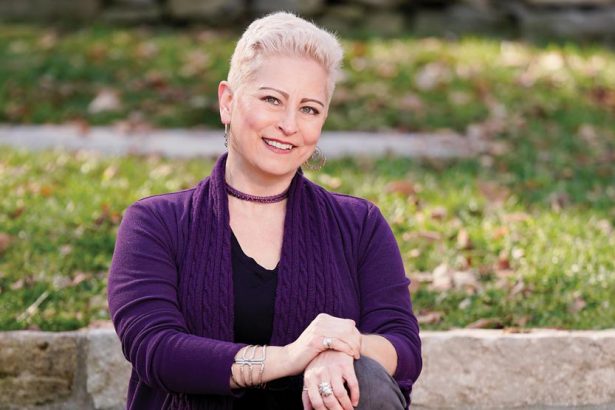Patient Search
 |
 |
|
KaCrole Higgins was diagnosed with breast cancer in 2020. “In May 2020, I found a lump in my breast. I cried. By June, it was diagnosed as breast cancer, triple positive, stage 1A. While getting this cancer diagnosis was devastating, it also became an opportunity. Suddenly, the cancer gave me clarity. It gave me clarity about what was important, what was good in my life, what was toxic in my life, and what I needed to do.” Click below to read more of KaCrole’s story |
If Landon Ryan had been diagnosed with bilateral retinoblastoma 10, 20 or 30 years ago, she might not be here today with nearly perfect vision.Thanks to recent improvements in the treatment for this rare form of cancer that almost exclusively affects children under the age of 5, the diagnosis had the power to change Landon’s life when she was 11 months old, but not to take it — or her eyesight. Click below to learn more about Landon and her story. https://momentum.vicc.org/2022/04/brighter-outlook/ |
Renal Tumors Classification, Biology, and Banking Study
Multiple Cancer Types
Pediatrics,
Wilms / Other Kidney (Pediatrics)
N/A
Benedetti, Daniel
NCT00898365
COGAREN03B2
Vincristine Pharmacokinetics in Infants
Pediatrics
Pediatrics
This pilot trial compares drug exposure levels using a new method for dosing vincristine in infants and young children compared to the standard dosing method based on body surface area (BSA) in older children. Vincristine is an anticancer drug used to a variety of childhood cancers. The doses anticancer drugs in children must be adjusted based on the size of the child because children vary significantly in size (height, weight, and BSA) and ability to metabolize drugs from infancy to adolescence. The dose of most anticancer drugs is adjusted to BSA, which is calculated from a patients weight and height. However, infants and young children have more severe side effects if the BSA is used to calculate their dose, so new dosing models have to be made to safely give anticancer drugs to the youngest patients. This new method uses a BSA-banded approach to determine the dose. Collecting blood samples before and after a dose of the drug will help researchers determine whether this new vincristine dosing method results in equivalent drug levels in the blood over time in infants and young children compared to older children.
Pediatrics
N/A
Borinstein, Scott
NCT05359237
COGPEPN22P1
Study to Learn More About the Safety and Effectiveness of the Drug VITRAKVI During Routine Use in Patients With TRK Fusion Cancer Which is Locally Advanced or Spread From the Place Where it Started to Other Places in the Body
Multiple Cancer Types
In this observational study researcher want to learn more about the effectiveness of drug
VITRAKVI (generic name: larotrectinib) and how well the drug is tolerated during routine use
in patients with TRK fusion cancer which is locally advanced or spread from the place where
it started to other places in the body. TRK fusion cancer is a term used to describe a
variety of common and rare cancers that are caused by a change to the NTRK (Neurotrophic
Tyrosine Kinase) gene called a fusion. During this fusion, an NTRK gene joins together, or
fuses, with a different gene. This joining results in the activation of certain proteins (TRK
fusion proteins), which can cause cancer cells to multiply and form a tumor. VITRAKVI is an
approved drug that blocks the action of the NTRK gene fusion. This study will enroll adult
and paediatric patients suffering from a solid tumor with NTRK gene fusion for whom the
decision to treat their disease with VITRAKVI has been made by their treating physicians.
During the study, patients' medical information such as treatment information with VITRAKVI,
other medication or treatments, changes in disease status and other health signs and symptoms
will be collected within the normal medical care by the treating doctor. Participants will be
observed over a period from 24 to 60 months.
VITRAKVI (generic name: larotrectinib) and how well the drug is tolerated during routine use
in patients with TRK fusion cancer which is locally advanced or spread from the place where
it started to other places in the body. TRK fusion cancer is a term used to describe a
variety of common and rare cancers that are caused by a change to the NTRK (Neurotrophic
Tyrosine Kinase) gene called a fusion. During this fusion, an NTRK gene joins together, or
fuses, with a different gene. This joining results in the activation of certain proteins (TRK
fusion proteins), which can cause cancer cells to multiply and form a tumor. VITRAKVI is an
approved drug that blocks the action of the NTRK gene fusion. This study will enroll adult
and paediatric patients suffering from a solid tumor with NTRK gene fusion for whom the
decision to treat their disease with VITRAKVI has been made by their treating physicians.
During the study, patients' medical information such as treatment information with VITRAKVI,
other medication or treatments, changes in disease status and other health signs and symptoms
will be collected within the normal medical care by the treating doctor. Participants will be
observed over a period from 24 to 60 months.
Pediatric Solid Tumors,
Pediatrics
N/A
Borinstein, Scott
NCT04142437
VICCPED2071
Studying Health Outcomes after Treatment in Patients with Retinoblastoma, RIVERBOAT Study
Multiple Cancer Types
This trial studies health outcomes after treatment in patients with retinoblastoma. Gathering health information over time from patients and family members through vision assessments, samples of tissue and saliva, and questionnaires may help doctors learn more about what causes retinoblastoma, identify long-term health outcomes for patients with retinoblastoma, and find out which therapies may be the best for treating retinoblastoma.
Pediatrics,
Retinoblastoma (Pediatrics)
N/A
Friedman, Debra
NCT03932786
VICCPED1878
Enasidenib for the Treatment of Relapsed or Refractory Acute Myeloid Leukemia Patients with an IDH2 Mutation
Multiple Cancer Types
This trial studies the side effects of enasidenib and to see how well it works in treating patients with acute myeloid leukemia that has come back after treatment (relapsed) or has been difficult to treat with chemotherapy (refractory). Patients must also have a specific genetic change, also called a mutation, in a protein called IDH2. Enasidenib may stop the growth of cancer cells by blocking the mutated IDH2 protein, which is needed for cell growth.
Pediatric Leukemia,
Pediatrics
II
Smith, Brianna
NCT04203316
COGADVL18P1
CAB-AXL-ADC Safety and Efficacy Study in Adult and Adolescent Patients With Sarcoma
Multiple Cancer Types
The objective of this study is to assess safety and efficacy of CAB-AXL-ADC in solid tumors
Miscellaneous,
Pediatric Solid Tumors,
Pediatrics,
Sarcoma
I/II
Davis, Elizabeth
NCT03425279
VICCSAR20117
Venetoclax in Children With Relapsed Acute Myeloid Leukemia (AML)
Multiple Cancer Types
A study to evaluate if the randomized addition of venetoclax to a chemotherapy backbone
(fludarabine/cytarabine/gemtuzumab ozogamicin [GO]) improves survival of
children/adolescents/young adults with acute myeloid leukemia (AML) in 1st relapse who are
unable to receive additional anthracyclines, or in 2nd relapse.
(fludarabine/cytarabine/gemtuzumab ozogamicin [GO]) improves survival of
children/adolescents/young adults with acute myeloid leukemia (AML) in 1st relapse who are
unable to receive additional anthracyclines, or in 2nd relapse.
Pediatric Leukemia,
Pediatrics
III
Smith, Christine
NCT05183035
VICCPED2237
Selinexor and Venetoclax in Combination with Chemotherapy for the Treatment of Relapsed or Refractory Acute Myeloid Leukemia or Acute Leukemia of Ambiguous Lineage
Multiple Cancer Types
This phase I trial evaluates the side effects and best dose of selinexor and venetoclax in combination with chemotherapy in treating patients with acute myeloid leukemia or acute leukemia of ambiguous linage that has come back (relapsed) or does not respond to treatment. Venetoclax may stop the growth of cancer cells by blocking Bcl-2, a protein needed for cancer cell survival. Selinexor may stop the growth of cancer cells by blocking CRM1, which help the body's immune system to find and kill cancer cells. Chemotherapy drugs, such as fludarabine and cytarabine, work in different ways to stop the growth of cancer cells, either by killing the cells, by stopping them from dividing, or by stopping them from spreading. Colony-stimulating factors, such as granulocyte colony-stimulating factor, may increase the production of blood cells and may help the immune system recover from the side effects of chemotherapy. Giving venetoclax and selinexor with chemotherapy may help control the disease in patients with acute myeloid leukemia or acute leukemia of ambiguous lineage.
Leukemia,
Pediatric Leukemia,
Pediatrics,
Phase I
I
Smith, Brianna
NCT04898894
VICCPEDP2235
A Trial Comparing Unrelated Donor BMT With IST for Pediatric and Young Adult Patients With Severe Aplastic Anemia (TransIT, BMT CTN 2202)
Pediatrics
Pediatrics
Severe Aplastic Anemia (SAA) is a rare condition in which the body stops producing enough new
blood cells. SAA can be cured with immune suppressive therapy or a bone marrow transplant.
Regular treatment for patients with aplastic anemia who have a matched sibling (brother or
sister), or family donor is a bone marrow transplant. Patients without a matched family donor
normally are treated with immune suppressive therapy (IST). Match unrelated donor (URD) bone
marrow transplant (BMT) is used as a secondary treatment in patients who did not get better
with IST, had their disease come back, or a new worse disease replaced it (like leukemia).
This trial will compare time from randomization to failure of treatment or death from any
cause of IST versus URD BMT when used as initial therapy to treat SAA.
The trial will also assess whether health-related quality of life and early markers of
fertility differ between those randomized to URD BMT or IST, as well as assess the presence
of marrow failure-related genes and presence of gene mutations associated with MDS or
leukemia and the change in gene signatures after treatment in both study arms.
This study treatment does not include any investigational drugs. The medicines and procedures
in this study are standard for treatment of SAA.
blood cells. SAA can be cured with immune suppressive therapy or a bone marrow transplant.
Regular treatment for patients with aplastic anemia who have a matched sibling (brother or
sister), or family donor is a bone marrow transplant. Patients without a matched family donor
normally are treated with immune suppressive therapy (IST). Match unrelated donor (URD) bone
marrow transplant (BMT) is used as a secondary treatment in patients who did not get better
with IST, had their disease come back, or a new worse disease replaced it (like leukemia).
This trial will compare time from randomization to failure of treatment or death from any
cause of IST versus URD BMT when used as initial therapy to treat SAA.
The trial will also assess whether health-related quality of life and early markers of
fertility differ between those randomized to URD BMT or IST, as well as assess the presence
of marrow failure-related genes and presence of gene mutations associated with MDS or
leukemia and the change in gene signatures after treatment in both study arms.
This study treatment does not include any investigational drugs. The medicines and procedures
in this study are standard for treatment of SAA.
Pediatrics
III
Connelly, James
NCT05600426
VICCPED2295



